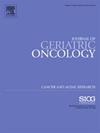年龄和合并症对转移性实体恶性肿瘤1期试验参与者安全性结果的影响
IF 2.7
3区 医学
Q3 GERIATRICS & GERONTOLOGY
引用次数: 0
摘要
导读:在过去的十年中,全球i期临床试验的数量一直在增加。然而,患者招募仍然倾向于年轻人群,老年人仍然不足,限制了普遍性。很少有研究系统地考察了合并症在1期临床试验中作为安全性结果决定因素的作用。因此,我们的目的是调查年龄和合并症对1期试验参与者安全性结果的影响。材料和方法:本回顾性分析检查了2020年1月至2023年5月期间参加转移性实体恶性肿瘤i期试验的年龄≥18岁患者的电子健康记录。患者分为两个年龄组(12岁。并对东部肿瘤合作组(ECOG)的工作状态进行评价。Logistic回归模型评估了年龄、合并症和安全性结局之间的关联:严重不良事件(SAE)、剂量限制性毒性(DLT)、剂量减少/中断(DR/DI)、因毒性而停止治疗(COTT)和3-5级毒性。结果:我们纳入229例患者,其中51例(22%)年龄≥70岁。其中79例(34%)发生SAE, 109例(48%)发生DR/DI, 34例(15%)发生COTT, 17例(7%)发生DLT, 99例(43%)发生3-5级不良事件。年龄与不良安全结果的高可能性无显著相关。然而,ECI≥4的患者发生SAE的可能性明显高于ECI患者。讨论:在转移性实体恶性肿瘤的1期临床试验中,年龄本身与安全性结果无关。相反,在我们的患者队列中,合并症负担和ECOG表现状态是不良事件的预测因素。本文章由计算机程序翻译,如有差异,请以英文原文为准。
Impact of age and comorbidity on safety outcomes in phase 1 trial participants for metastatic solid malignancies
Introduction
The number of phase 1 clinical trials has been increasing globally over the past decade. However, patient recruitment remains skewed towards younger populations with older adults remaining underrepresented, limiting generalizability. Few studies have systematically examined the role of comorbidities as a determinant of safety outcomes in phase 1 trials. Thus, we aimed to investigate the impact of age and comorbidity on safety outcomes of phase 1 trial participants.
Materials and Methods
This retrospective analysis examined electronic health records of patients aged ≥18 years enrolled in phase 1 trials for metastatic solid malignancies between January 2020 and May 2023. Patients were stratified into two age groups (<70 years vs. ≥70 years). Patients were classified as comorbid if they had Charlson Comorbidity Index (CCI) ≥3, Elixhauser Comorbidity Index (ECI) ≥4, or modified Elixhauser Comorbidity Index (mECI) >12. Eastern Cooperative Oncology Group (ECOG) performance status was also evaluated. Logistic regression models assessed associations between age, comorbidity, and safety outcomes: serious adverse events (SAE), dose-limiting toxicities (DLT), dose reductions/interruptions (DR/DI), cessation of treatment due to toxicity (COTT), and grade 3–5 toxicities.
Results
We included 229 patients, of whom 51 (22%) were aged ≥70 years. Among them, 79 (34%) experienced an SAE, 109 (48%) had DR/DI, 34 (15%) had COTT, 17 (7%) had DLT, and 99 (43%) developed grade 3–5 adverse events. Age was not significantly associated with a higher likelihood of adverse safety outcomes. However, patients with ECI ≥4 had significantly higher likelihood of SAE than those with ECI <4 (50% vs. 31%, p = 0.04, OR: 2.18, 95% CI: 1.08–4.44). Patients with ECOG ≥1 had higher likelihood of SAE than those with ECOG 0 (42% vs. 29%, p = 0.06, OR: 1.75, 95% CI: 1.01–3.05, p = 0.05). Patients with ECOG ≥1 had significantly higher likelihood of grade 3–5 adverse events than those with ECOG 0 (52% vs. 36%, p = 0.03, OR: 1.89, 95% CI: 1.11–3.23, p = 0.02). Other comorbidity indices were not significantly associated with safety outcomes.
Discussion
Age alone was not associated with safety outcomes in phase 1 clinical trials for metastatic solid malignancies. Instead, comorbidity burden and ECOG performance status were predictors of adverse events in our cohort of patients.
求助全文
通过发布文献求助,成功后即可免费获取论文全文。
去求助
来源期刊

Journal of geriatric oncology
ONCOLOGY-GERIATRICS & GERONTOLOGY
CiteScore
5.30
自引率
10.00%
发文量
379
审稿时长
80 days
期刊介绍:
The Journal of Geriatric Oncology is an international, multidisciplinary journal which is focused on advancing research in the treatment and survivorship issues of older adults with cancer, as well as literature relevant to education and policy development in geriatric oncology.
The journal welcomes the submission of manuscripts in the following categories:
• Original research articles
• Review articles
• Clinical trials
• Education and training articles
• Short communications
• Perspectives
• Meeting reports
• Letters to the Editor.
 求助内容:
求助内容: 应助结果提醒方式:
应助结果提醒方式:


